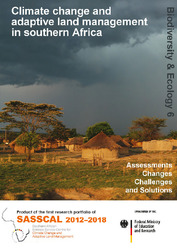| dc.identifier.citation | Ramoelo, A., Stolter, C., Joubert, D., Cho, M.A., Groengroeft, A., Madibela, O.R., Zimmermann, I. & Pringle, H. (2018) Rangeland monitoring and assessment: a review. In: Climate change and adaptive land management in southern Africa – assessments, changes, challenges, and solutions (ed. by Revermann, R., Krewenka, K.M., Schmiedel, U., Olwoch, J.M., Helmschrot, J. & Jürgens, N.), pp. 170-176, Biodiversity & Ecology, 6, Klaus Hess Publishers, Göttingen & Windhoek. doi:10.7809/b-e.00320 | en_US |
| dc.description.abstract | Rangelands provide vast landscapes for grazing and foraging for livestock and wildlife. Services of rangelands are diverse and generally provide food for millions of the world’s population, especially the rural and sometimes poor communities. Despite the importance of rangelands, they are also threatened by global change including land use and climate change. Land-use change is exacerbated by the ever-increasing human population, which is projected to reach over 9 billion in 2050. Meanwhile, climate change in the form of erratic rainfall and increasing temperatures, favours increasing woody cover leading to bush encroachment and recurrent droughts. The objective of this overview article is to provide a synopsis of the key areas covered by the subsequent articles, and drawing upon a wider body of literature. Key issues highlighted in this chapter are the defi nition of rangeland landscapes, their role and threats such as bush encroachment, land degradation (e.g. soil erosion), indicators for monitoring (i.e. quality of grass, trees, and legumes), and assessment of rangelands using in situ and remote sensing techniques. The threats of soil erosion, fi re, and bush encroachment are discussed in relation to the functioning of these landscapes for wildlife and livestock. However, in situ and remote sensing techniques provide the opportunity to assess the status or condition, quality, and extent of rangeland environments. | en_US |

